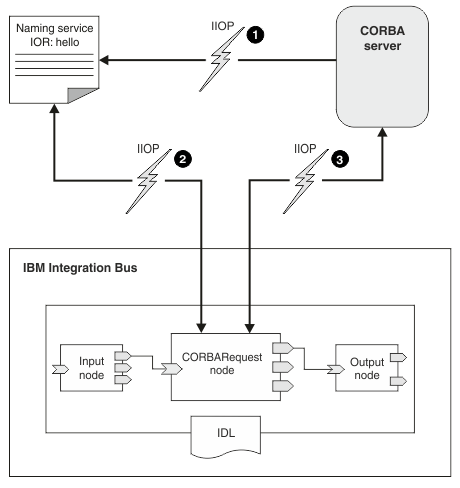
The CORBA nodes sample consists of multiple process flows within one message flow. These process flows include:
The following overview diagram shows the relationships between the message flow on IBM Integration Bus, the naming service, and the CORBA server Java application.

This process flow consists of the following nodes:

The integration node receives a message request from a WebSphere MQ queue.
The Compute node:
This process flow consists of the following nodes:

The Label node receives the routed message request. The CORBARequest node invokes the createNewStockItem operation of the CORBA server application that is passing the input parameters, and returns a response.
A Compute node copies the response data to the local environment and sets up the input parameters for the next CORBA request. The next CORBARequest node invokes the setPrice operation of the CORBA server application that is passing the input parameters, and returns a response.
A final Compute node copies the response data to the local environment, then copies all the accumulated responses from the CORBARequest nodes to the message body to be propagated to a WebSphere MQ queue.
Any user-defined exceptions that are thrown from the CORBA server Java application are propagated down the Error terminal of the CORBARequest node to another WebSphere MQ queue.
This process flow consists of the following nodes:

The Label node receives the routed message request. The CORBARequest node invokes the addStock operation of the CORBA server application that is passing the input parameters, and returns a response that is propagated to a WebSphere MQ queue.
Any user-defined exceptions that are thrown from the CORBA server Java application are propagated down the Error terminal of the CORBARequest node to another WebSphere MQ queue.
This process flow consists of the following nodes:

The Label node receives the routed message request. The CORBARequest node invokes the getSKU operation of the CORBA server application that is passing the input parameters, and returns a response.
A Compute node copies the response data to the local environment and sets up the input parameters for the next CORBA request. The next CORBARequest node invokes the getPrice operation of the CORBA server application that is passing the input parameters, and returns a response.
Another Compute node copies the response data to the local environment and sets up the input parameters for the next CORBA request. The next CORBARequest node invokes the getStockLevel operation of the CORBA server application that is passing the input parameters, and returns a response.
A final Compute node copies the response data to the local environment, then copies all the accumulated responses from the CORBARequest nodes to the message body to be propagated to a WebSphere MQ queue.
Any user-defined exceptions that are thrown from the CORBA server Java application are propagated down the Error terminal of the CORBARequest node to another WebSphere MQ queue.
This process flow consists of the following nodes:

The Label node receives the routed message request. The CORBARequest node invokes the reduceStock operation of the CORBA server application that is passing the input parameters, and returns a response that is propagated to a WebSphere MQ queue.
Any user-defined exceptions that are thrown from the CORBA server Java application are propagated down the Error terminal of the CORBARequest node to another WebSphere MQ queue.
This process flow consists of the following nodes:

The Label node receives the routed message request. The CORBARequest node invokes the deleteStockItem operation of the CORBA server application that is passing the input parameters, and returns a response that is propagated to a WebSphere MQ queue.
Any user-defined exceptions that are thrown from the CORBA server Java application are propagated down the Error terminal of the CORBARequest node to another WebSphere MQ queue.